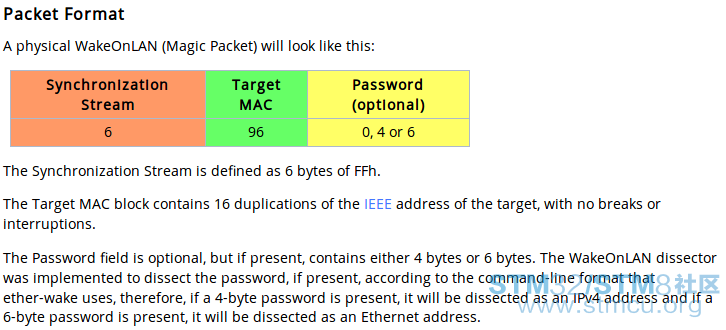不想打开笔记本盖子按开机按钮开机?可以使用Wake-on-LAN远程唤醒。这里展示怎么用NUCELO-F767ZI以太网功能发送MagicPacket唤醒笔记本电脑。
http://blog.csdn.net/zoomdy/article/details/54799462
mingdu.zheng at gmail dot com
缘起:不想开盖按电源按钮
因为有一台23吋显示器,笔记本电脑在家里基本上当台式机用。每次开机的时候都要打开翻盖按一下电源按钮然后又合上,嫌开盖开机麻烦,然后就在网上找不开盖就能开机的方法,唯一靠谱的方案就是Wake-on-LAN,即局域网唤醒,简称WOL。正好有一块NUCLEO-F767ZI开发板,这是一款带以太网的开发板,可以用来发送MagicPacket唤醒我的笔记本电脑。

设置BIOS
要使用Wake-on-LAN功能,首先要进入BIOS打开Wake-on-LAN功能,不同的机器其设置位置可能不同,进BIOS找一找。也有可能不被支持。
验证Wake-on-LAN可以工作
这里以Ubuntu 12.04为例,Windows环境可以问度娘。首先使用ethtool工具检查需要被唤醒的机器是否正确打开了Wake-on-LAN功能,请注意ethtool工具输出的两条信息 Supports Wake-on: pumbg 和 Wake-on: g,Supports Wake-on说明是否具备Wake-on-LAN功能,Wake-on为g说明已经打开了Wake-on-LAN,如果Wake-on为d说明Wake-on-LAN被关闭了,更具体的内容可以 man ethtool。
- sudo apt-get install ethtool
- sudo ethtool eth0
- Settings for eth0:
- ......
- Supports Wake-on: pumbg
- Wake-on: g
- sudo apt-get install wakeonlan
- wakeonlan 28:D2:44:3E:07:56
- Sending magic packet to 255.255.255.255:9 with 28:D2:44:3E:07:56
如果设置没有错的话,稍等几秒钟就可以看到机器被唤醒了。
唤醒的原理
wakeonlan命令会发送一个目标端口为9的UDP广播数据包:MagicPacket,待唤醒机器的网卡接收到MagicPacket后,就会唤醒计算机。MagicPacket的格式如下图所示,开头是6字节FF,后面复制16份待唤醒机器的MAC地址。

关于Wake-on-LAN更详细的内容可以参考这里:http://wiki.wireshark.org/WakeOnLAN
用NUCLEO-F767ZI实现唤醒
如果要用另外一台电脑输入命令来唤醒我的笔记本电脑,那比开盖更麻烦啊!我的预期是:按下排插按钮就可以自动唤醒。正好我有一块NUCLEO-F767ZI开发板,这是一块带有以太网功能的开发板,可以用NUCLEO-F767ZI发送MagicPacket唤醒机器。
首先参考这篇http://blog.csdn.net/zoomdy/article/details/54784027将以太网功能跑通。
然后修改lwIP配置,使用静态地址方式,DHCP获取地址是需要时间的,静态地址可以快很多。

编写代码,在NUCLEO-F767ZI上电后发送一个MagicPacket,这是一个UDP包,使用lwIP的udp_*系列API来实现。没有使用socket接口,也没有加入FreeRTOS,这是个简单的应用,简单一些就可以了。
完整的源代码请访问:http://git.oschina.net/zoomdy/Wake-on-LAN,这里给出关键代码。
- /*
- * Src/wol.c
- * http://wiki.wireshark.org/WakeOnLAN
- *
- * Packet Format
- * |Synchronization Stream |Target MAC |Password (optional) |
- * |6 |96 |0, 4 or 6 |
- *
- * The Synchronization Stream is defined as 6 bytes of FFh.
- *
- * The Target MAC block contains 16 duplications of the IEEE address
- * of the target, with no breaks or interruptions.
- *
- * The Password field is optional, but if present, contains either 4
- * bytes or 6 bytes. The WakeOnLAN dissector was implemented to dissect
- * the password, if present, according to the command-line format that
- * ether-wake uses, therefore, if a 4-byte password is present, it will
- * be dissected as an IPv4 address and if a 6-byte password is present,
- * it will be dissected as an Ethernet address.
- */
- #include <stdint.h>
- #include <string.h>
- #include "stm32f7xx_hal.h"
- #include "lwip.h"
- #include "lwip/udp.h"
- #include "wol.h"
- void Error_Handler(void);
- // 被唤醒机器的MAC地址
- static const uint8_t targetAddress[ETHARP_HWADDR_LEN] =
- { 0x28, 0xd2, 0x44, 0x3e, 0x07, 0x56 };
- static void fillMagicPacket(uint8_t buf[])
- {
- int i;
- memset(&buf[0], 0xff, ETHARP_HWADDR_LEN);
- for (i = 0; i < 16; i++)
- {
- memcpy(&buf[(1 + i) * ETHARP_HWADDR_LEN], &targetAddress[0],
- ETHARP_HWADDR_LEN);
- }
- }
- static void sendMagicPacket(void)
- {
- static struct udp_pcb *pcb = NULL;
- struct pbuf *pbuf = NULL;
- err_t err;
- if (pcb == NULL)
- {
- pcb = udp_new();
- if (pcb == NULL)
- {
- Error_Handler();
- }
- err = udp_connect(pcb, IP_ADDR_BROADCAST, 9);
- if (err != ERR_OK)
- {
- Error_Handler();
- }
- }
- pbuf = pbuf_alloc(PBUF_TRANSPORT, (1 + 16) * ETHARP_HWADDR_LEN,
- PBUF_RAM);
- if (pbuf == NULL)
- {
- Error_Handler();
- }
- fillMagicPacket(pbuf->payload);
- err = udp_send(pcb, pbuf);
- if (err != ERR_OK)
- {
- Error_Handler();
- }
- pbuf_free(pbuf);
- pbuf = NULL;
- #if 0 // 不要释放pcb,后面还要用
- udp_remove(pcb);
- pcb = NULL;
- #endif
- }
- void WOL_Process(void)
- {
- static int fired = 0;
- uint32_t tick;
- tick = HAL_GetTick();
- if(fired == 0 && tick >= 2000) // 上电2秒后发送Magic Packet
- {
- sendMagicPacket();
- HAL_GPIO_WritePin(GPIOB, LED_RED_Pin, GPIO_PIN_SET);
- fired = 1;
- }
- }
- void BTN_Process(void)
- {
- static uint32_t tick_prev = 0;
- static uint32_t btn_state = 0;
- uint32_t tick;
- tick = HAL_GetTick();
- if(tick != tick_prev)
- {
- tick_prev = tick;
- btn_state <<= 1;
- if(HAL_GPIO_ReadPin(BTN_USER_GPIO_Port, BTN_USER_Pin))
- {
- btn_state |= 1;
- HAL_GPIO_WritePin(GPIOB, LED_BLUE_Pin, GPIO_PIN_SET);
- HAL_GPIO_WritePin(GPIOB, LED_RED_Pin, GPIO_PIN_RESET);
- }
- else
- {
- btn_state |= 0;
- HAL_GPIO_WritePin(GPIOB, LED_BLUE_Pin, GPIO_PIN_RESET);
- }
- if(btn_state == 0xffff0000) // 按钮释放立即发送Magic Packet
- {
- sendMagicPacket();
- HAL_GPIO_WritePin(GPIOB, LED_RED_Pin, GPIO_PIN_SET);
- }
- }
- }
- void LED_Process(void)
- {
- if(HAL_GetTick() & 0x100)
- {
- HAL_GPIO_WritePin(GPIOB, LED_GREEN_Pin, GPIO_PIN_SET);
- }
- else
- {
- HAL_GPIO_WritePin(GPIOB, LED_GREEN_Pin, GPIO_PIN_RESET);
- }
- }
- /*
- * Src/main.c 仅给出main函数部分
- */
- int main(void)
- {
- /* USER CODE BEGIN 1 */
- /* USER CODE END 1 */
- /* MCU Configuration----------------------------------------------------------*/
- /* Reset of all peripherals, Initializes the Flash interface and the Systick. */
- HAL_Init();
- /* Configure the system clock */
- SystemClock_Config();
- /* Initialize all configured peripherals */
- MX_GPIO_Init();
- MX_USART3_UART_Init();
- MX_LWIP_Init();
- /* USER CODE BEGIN 2 */
- /* USER CODE END 2 */
- /* Infinite loop */
- /* USER CODE BEGIN WHILE */
- while (1)
- {
- /* USER CODE END WHILE */
- /* USER CODE BEGIN 3 */
- MX_LWIP_Process();
- WOL_Process();
- BTN_Process();
- LED_Process();
- __WFE(); // Save 40mA
- }
- /* USER CODE END 3 */
- }
最后
用NUCLEO-F767ZI做这么简单的工作是不是大材小用了?过了元宵节,买块NUCLEO-F207ZG,终于有理由买NUCLEO-F207ZG了。
|






谢谢分享!